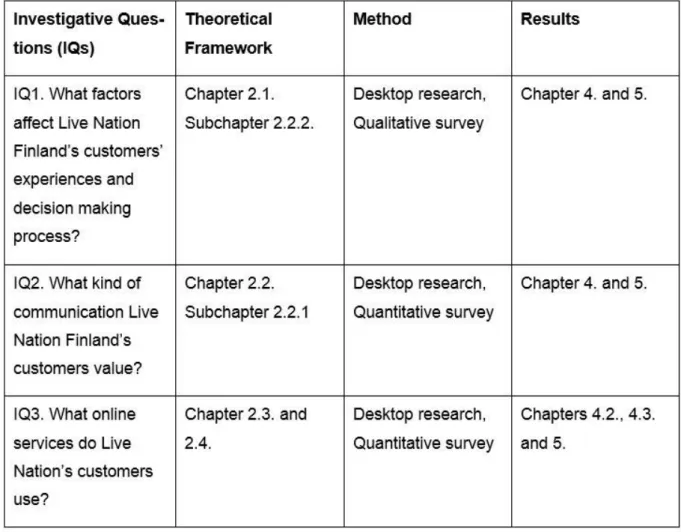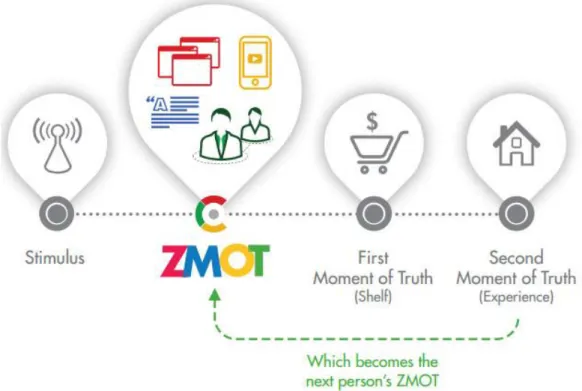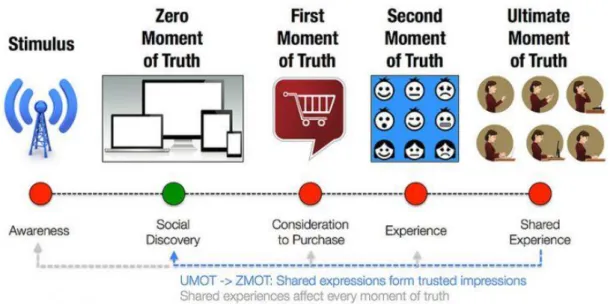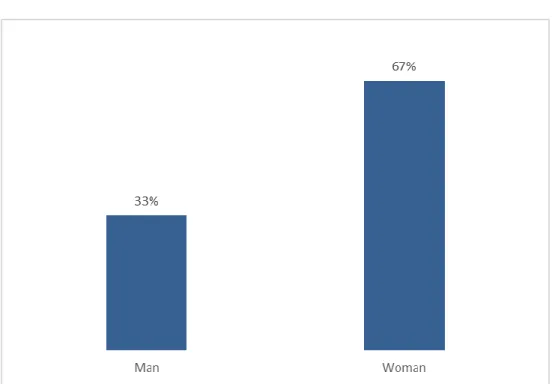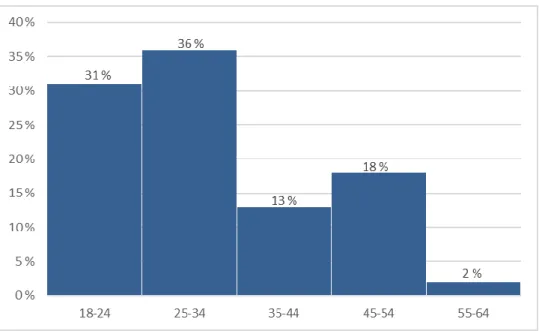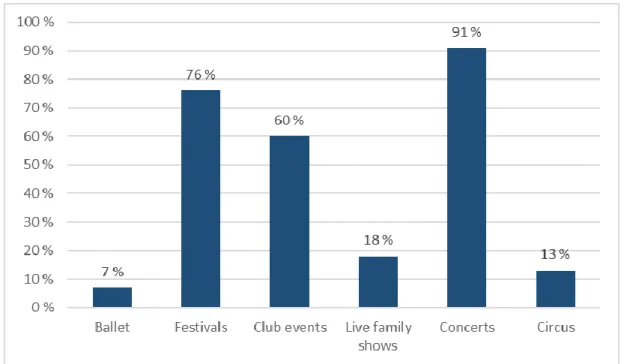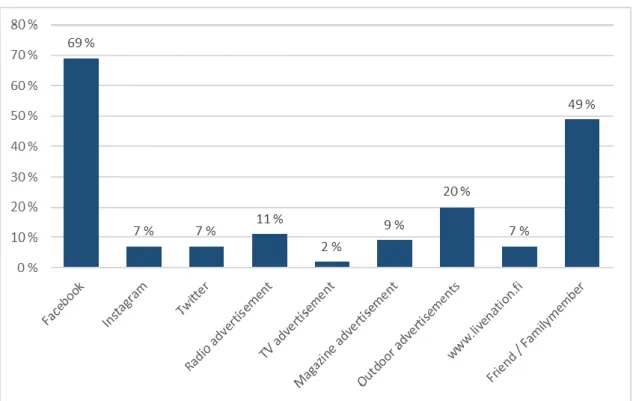The aim of this dissertation is to show how online activities and social media channels can be used effectively to create better experiences for customers. To provide a broader understanding of the process, this dissertation discusses experience management and design, as well as the opportunities offered by social media for the pre- and post-marketing of events.
Background
The purpose of this thesis is to present how online social networks relate to creating memorable experiences for customers.
Research problem
International aspect
Demarcation
Key concepts
Customer experience management aims to discover what customers expect from a company and how these expectations, as well as experiences with the company, can be monitored. The process of customer experience management is used to track interaction between customers and a business and it influences decisions made to change customer expectations as well as experience design.
Case company introduction
Social media platforms are Internet-based environments in which user-generated content can be shared and explored with peers and followers, as well as with unknown users, depending on the platform used. The third and fourth subsections provide information about the social media and platforms used by Live Nation Finland.
Experience management, marketing and design
In connection with experiential marketing, it is necessary to know who you are marketing the experience to in order to plan it. Otherwise, the experience will not be delivered to the customers to its full potential, and it is highly likely that it will not engage some of the customers.
Customer understanding
Change in consumer behaviour
So it's crucial for businesses to listen to their customers' needs and create positive, memorable experiences they can share, as discussed in Section 2.1. It is normal for them to check into places and therefore inform their friends and followers about where they are and what they are doing.
Customer experience management
The four moments of truth are Zero Moment of Truth, First Moment of Truth, Second Moment of Truth and the Ultimate Moment of Truth. As an addition to original steps, Lecinski (2011) identified another moment of truth that was a logical consequence of the change in consumer behavior.
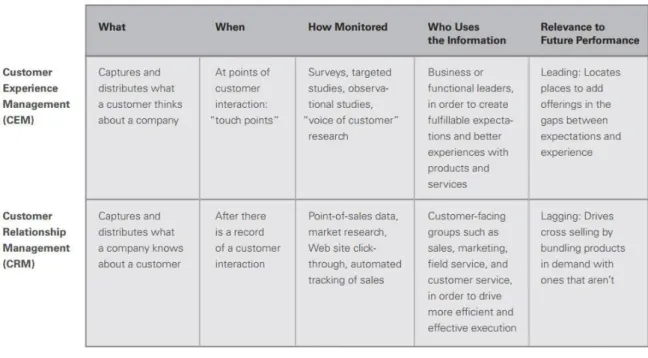
Social media marketing
A clear benefit of social media is the fact that consumers are participating in the marketing process. To add real value to customers as well as business, social media marketing needs to be planned accordingly. This includes reviewing the existing marketing plan, environmental and customer analyses, and outlining the current social media presence.
The last thing to do is create an evaluation plan to define performance metrics that will be used to track the success of social media activities. In terms of event organization, social media can be used to facilitate collaboration and communication between participating organizers. Various social media platforms allow discussion of the event elements and can also be used for attendance confirmation to anticipate the size of the event.
Social media can also be a great asset in enhancing the direct experiences created for customers. An efficient way is for example to film the event and upload an edited version of the video to YouTube and share it through other social media channels.
Social media platforms
Posting pictures of the event is also an effective way to keep attention around it. Enhancing the experience through social media also works for people who couldn't attend the event, as they can also view all the content that was created at the event and contribute to the discussion. As mentioned earlier, it is important to consider the customer experience before, during and after the event.
Video allows customers to return to the event location and remember the feelings they experienced. Another useful way is to share photos of the event, for example if a professional photographer is taking photos or a photo booth. These types of activities also attract new visitors as they gain a better understanding of what to expect from the next event, and at the same time they can generate valuable information for the organizers about what worked and what didn't, and whether the customers liked the event or not.
Based on videos, it offers its users the ability to search, watch and share videos uploaded to the platform. Tweets can be very powerful and are often used to convey messages to society about what is happening and how people feel about it.
Conclusion of theory
This chapter presents the research methods used, which aimed to gain a better understanding of the online behavior of Live Nation Finland's customers and how experiences could be created for them in online environments to add value to the interaction. The chapter provides information on how the research was designed and how the collected information was analysed.
Research Design
In addition, it served as the basis for recommendations offered to the company handling the case and as general guidelines for creating online experiences.
Reliability and Validity
The client agreed to send the survey to its clients, which ensured that the right target groups were reached. The survey was placed on the company's newsletter, which is currently sent out weekly on Fridays.
Analysis Methods
Demographics of the respondents
This chapter is intended exclusively for a neutral presentation of the findings of the conducted research.
Questions related to events in general
Concerts are clearly the most attended events, as slightly more than 90% of respondents attended. Through these channels, 20% of respondents reported seeing an outdoor ad about the event, and 11% heard about it on the radio. It is closely followed by Google, as slightly more than 60% of respondents use it to search for information.
The most common factor influencing the respondents' decision to attend an event was the performer or an artist of the event, as 100% of respondents chose this option. Another important factor, as more than half of the respondents said, was the time and place of the event. Nearly 50% of respondents also value recommendations from friends as well as previous experiences, as shown in Figure 10.
The most common reason for not attending an event of interest was that the date of the event was not convenient for the respondents, as 82% of them responded. Another notable reason was that the tickets were too expensive, which was the case for more than half of the respondents.
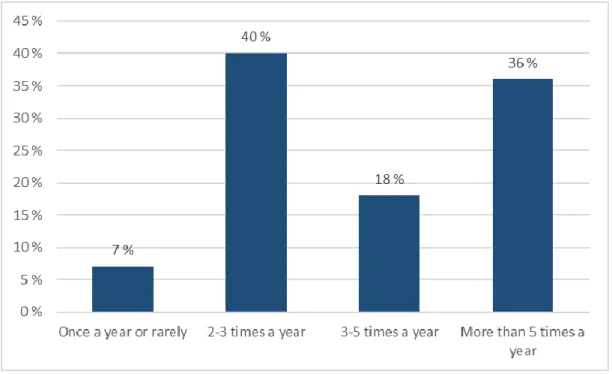
Social media related questions
The fact that a respondent had just seen the show or that they heard about it too late were also common reasons, with almost 30% of respondents responding. Over 70% of respondents would like to receive information about upcoming events through social networks. Almost half of them also want to see video clips of the organized events, and 40% say they want to see pictures of events.
The discussion part of the thesis concludes the findings of the research from both theoretical and empirical fields. It looks at the current situation and preferences of Live Nation Finland's customers, which is based on the survey conducted. The discussion also includes suggestions on how to improve the experiences offered to the customers and highlights some potential development points.

Key findings and what they mean
Live Nation Finland's customers reported that they also mostly search for information about the events on Facebook. The experience begins with stimuli, or awareness of the event and ends with the post-event activities. Interestingly, more than half of respondents still reported not attending an event due to ticket prices being too high.
The results of respondents' social media usage showed that Facebook is indeed used by almost all respondents, which also adds to the previous observations of Facebook's role in the lives of Live Nation Finland's customers. Nearly half of the respondents also claim that they follow Live Nation Finland on Facebook, suggesting that the company's presence there is valuable to the customers. Other popular social media channels were YouTube and Instagram, which clearly more than half of the respondents reported using them.
A few respondents said they are also present on Google+, but none of them follow Live Nation Finland. In terms of what Live Nation Finland's customers value and what kind of content they expect the company to produce, most respondents said they would like to receive information about upcoming events.
Development proposals
They can be used for three of the four stages of event marketing defined by Charlesworth and discussed in Chapter 2.3. Photos and video can be used for promotional purposes to create an attractive image of the upcoming event, to enhance the experience by sharing photos and videos of it during the event, and to extend the lifecycle of the event by posting videos of it upload to YouTube and publish photos taken during the event, including for customer use after the event. Given the content created, as evidenced by Live Nation Finland customer feedback, photos and videos are of interest to consumers.
As stated in an article on the Global Web Index by McGrath (2016), about half of the users of the Internet now upload their own videos to social networks. Therefore, the majority of survey respondents also contribute to these statistics, and it would be an advantage for Live Nation Finland to improve its video content.
Validity and Reliability
Suggestions for Further Research
The company already shares both materials on different channels, but since the video is now trending, it may get more attention. It can be useful to read articles from for example Forbes.com and Harvard Business Review as they often give up-to-date advice for businesses on how to use social media channels for marketing and also inform what is trending among customers in different times. URL: https://moz.com/blog/ultimate-moment-of-truth-moving-toward-shared-experiences Accessed: May 2, 2016.
Quantitative survey
